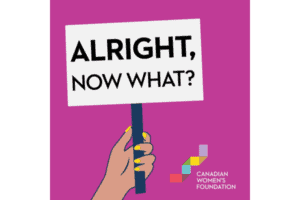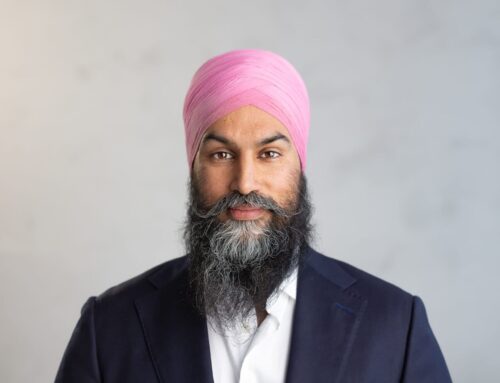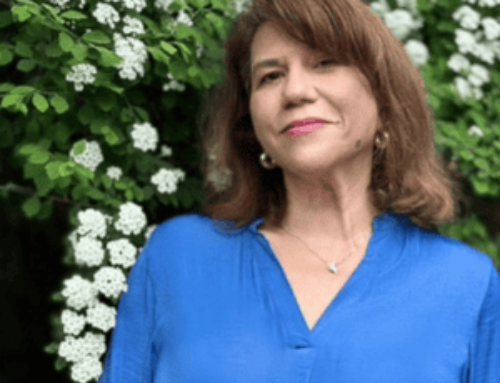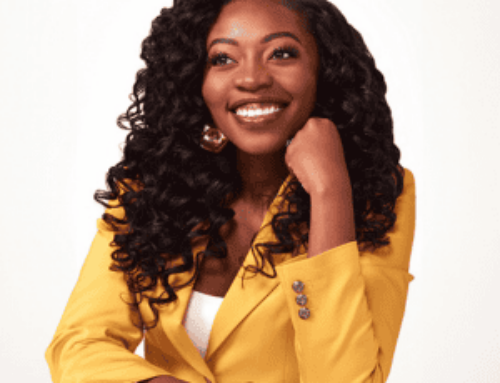 Misogynoir is a term coined by Moya Bailey to describe the unique form of anti-Black sexism faced by Black women. It’s a key topic explored in the documentary, Subjects of Desire, an award-winning documentary written, directed, and produced by Jennifer Holness and Hungry Eyes Media. The film explores Black women and beauty standards and interrelated topics like misogynoir and gender-based violence.
Misogynoir is a term coined by Moya Bailey to describe the unique form of anti-Black sexism faced by Black women. It’s a key topic explored in the documentary, Subjects of Desire, an award-winning documentary written, directed, and produced by Jennifer Holness and Hungry Eyes Media. The film explores Black women and beauty standards and interrelated topics like misogynoir and gender-based violence.
Paulette Senior, President and CEO of the Canadian Women’s Foundation, joins us to talk about these essential matters as we recognize and mark Black History Month as well as look forward to International Women’s Day on March 8. Paulette Senior has devoted her life and career to breaking down systemic barriers and building up diverse women and girls. Her personal experience immigrating to Canada from Jamaica as a young girl ignited her interest in social justice and helped make her the dynamic, grounded leader she is today. She is a sought-after thought-leader on numerous issues including gender equity and gender-based violence, women’s poverty and the gender pay gap, girls’ empowerment, and leadership. Her focus at the Canadian Women’s Foundation is to bolster an inclusive national movement for all women, girls, and communities across Canada.
Register for our March 3rd Panel Discussion, Black Women + Beauty Standards: A Conversation on Subjects of Desire. After signing up, you will receive a free private link to view the film in advance.
Transcript
00:00:00 Andrea
Hi, I’m Andrea at the Canadian Women’s Foundation.
Misogynoir is an important term coined by Moya Bailey to describe the unique form of anti-Black sexism faced by Black women. It’s also a key topic explored in the documentary Subjects of Desire written, directed and produced by Jennifer Holness and Hungry Eyes Media. We’re talking about it today as we recognize and mark Black History Month as well as look forward to International Women’s Day on March 8.
Welcome to Alright, Now What?, a podcast of the Canadian Women’s Foundation. We put an intersectional feminist lens on stories that make you wonder “Why is this still happening?” We explore systemic roots and strategies for change that will move us closer to the goal of gender justice.
The work of the Canadian Women’s Foundation and our partners takes place on traditional First Nations, Métis, and Inuit territories. We are grateful for the opportunity to meet and work on this land. However, we recognize that land acknowledgements are not enough. We need to pursue truth, reconciliation, decolonization, and allyship in an ongoing effort to make right with all our relations.
00:01:08 Andrea
Paulette Senior, President and CEO of the Canadian Women’s Foundation, joins me to talk about Black women and beauty standards and interrelated issues like misogynoir and gender-based violence.
The film shows that though some might argue that Black women are having a beauty moment, Black women themselves speak to traditional black features and attributes being seen as more desirable when they’re on white women. Can you address this contradiction? What do you think it means, what it’s rooted in and its impact on Black women and girls today?
00:01:37 Paulette
That’s a very deep question on so many levels, and it’s hard to know where to begin, but you know, Subjects of Desire to me is a necessary film. It’s really taking an in-depth look at the dynamic that’s created around beauty to begin with, what’s seen as beautiful and who kind of inhabits the skin of that beauty.
We know that for so long, particularly since colonialism, beauty has been defined by the colonizer and those standards of beauty have shifted with fashion, with seasons and somehow those standards of beauty have never really been attributed to Black bodies, and in particular Black women.
What I see, that’s been happening for decades, you know, I’m now of a certain age that I can actually look back and look at my own sort of childhood, growing up and ideas of beauty and desire. And it’s been a struggle for generations for Black women to actually be seen and viewed as beautiful, but also be able to understand what that beauty is and make our own sort of defined standards of beauty.
So, we have never been at the forefront of it, despite winning all kinds of beauty contests, but somehow we set the trend and the way we know we set the trend is because we’re copied, time and again. Right, so our own creation of beauty and empowerment is copied time and again in terms of our looks, in terms of our fashion, in terms of our bodies, where at one moment we’re not desired because our butts may be too big. And there was a moment in time when as young girls, some of us used to wear clothes that would de-enhance our butts so that it didn’t show up too much because it wasn’t in style. And then we started to embrace that and lo, behold, that’s what’s in style today.
I’m just amazed by how the shifting happens and the co-option of Black culture, of Black images, Black beauty becomes commodified by dominant culture, in this case white women. And they then become who we haven’t been appreciated to be. At a time when social media has really put these messages in their faces every single day, girls, young girls, young women, all of us are seeing these images and trying to come to terms with how did that happen? When did that happen?
Then if you kind of step back and look at it through sort of systems of oppression, whether that be gender and race and class all sort of mixed in, then you know you can actually see the trend in a different way, because really this is where the term misogynoir fits in perfectly because it is anti-Black, anti-woman and it is really exposing the falseness about what beauty is. Actually brings me back to my own childhood a little bit, and you know my teenage years and being a still fairly new immigrant in Canada and trying to find my own way towards what growing up and being beautiful or desired is and trying to find my path through that. And I remember in my early teens I got into the whole makeup thing and it was so difficult to find makeup that would actually fit your skin. Thinking that that’s where my power lies is in me being able to portray that beauty and decades later, there’s sort of a coming to terms and understanding that beauty, you know you’ve heard the term that beauty is skin deep, well beauty is from the inside. But as a society, whether we’re Black or white or Indigenous or disabled or whatever, our identities, multiples of identities are, it seems to have taken us lifetimes to realize that beauty is not externally defined, but internally expressed. And until we get that beneath our skin, I think we’ll continue to have to have these conversations.
00:06:22 Andrea
I’m really appreciative of the fact that you named misogynoir, let’s dig into that a little bit more.
It’s a term that was coined by Moya Bailey and she’s a professor at the Department of Communication Studies at Northwestern University. It’s really insightful because it combines the idea of misogyny and noir to describe the unique anti-Black sexism that’s faced by Black women. Subjects of Desire really touches on how misogynoir is connected to experiences of gender-based violence. That’s a real concern for us at the Canadian Women’s Foundation, and is a concern, period, in our world.
Tell us more about how this plays out in Canada right now. What changes you think needs to happen to ensure the rights and safety of Black women, girls and gender diverse people?
00:07:05 Paulette
You know, I do think we’re at a critical point of being able to change that understanding and dynamic with Black, Indigenous and racialized folks and gender nonbinary folks. That point that I think we’re at is being able to embrace our differences in a way that is empowering and defies, I will say, man-made standards.
Our differences have made us vulnerable to many things, including gender-based violence.
Our differences have made us susceptible to messages that have dehumanized us.
What I’m trying to do, in my own sort of leadership and work at the Foundation and life, is to reverse that trend and to engage in work and conversations and public policy dialogue around recognizing the inadequacy of current dynamics to actually address gender-based violence. The increased vulnerabilities, especially when you’re looking at the impact of the pandemic that is now un-ignorable on racialized and Indigenous, and all kinds of folks that are seen as different and not the norm- that impact has made us so susceptible to so many systems of oppression that we have to be able to see through that and reshape our interventions, our programs, our initiatives to center folks like that. And if you look at the work within the charitable sector or even in the woman sector, we’ve been at this work for a long time, but we have become adept at leaving folks in their vulnerability and living with what that has meant, which is increased violence, increased oppression., you know, leaving folks on the margins and keep doing the work we’re doing, which has been entirely ineffective. And I think the pandemic is now saying that we have failed to actually make an impact on those who are most vulnerable.
And so now it is time to look at that work in a very different way, to assess ourselves honestly and with transparency and re-center our work to be much more honest and focused and effective to transform our leadership and our organisations into ones that are responsive to these issues. Our strategic plans, our boards, our staff, our communities need to take a real look at those who are living on the margins and assess ourselves in a way to say OK, so what do we need to do differently for the voices and faces and identities that are missing from our conversations, in order to actually make this change?
I’m actually excited about what’s possible, whether it’s financial investments in this work, as well as public policy focus on the work that needs to be done, as well as measuring our impact through the lens of where are we investing our resources, our dollars, our time, our energy, in order to save the lives of those who have been most vulnerable.
It’s not just in the gender equality space, but it really shows up there most pronounced because when I think of young people, Black and racialized and Indigenous youth, when I think of their realities, for example, it is so clear that those who are most vulnerable among us are being ostracized, being killed, being left without homes are suffering from many kinds of discrimination whether it’s in education or in health care. I think the pandemic has revealed the significant cavern, not just gap, but cavern that needs to be seen and addressed and can’t be stepped over. You know gaps we’ve been able to step over but caverns we fall in.
00:11:45 Andrea
One of the things that is so clear, particularly when you’re looking at data for the experience of gender-based violence, that Black women and girls and gender diverse people face- so hard to find that data. I think that alone tells us that we’ve invisiblized these issues. We have ignored these issues, but it doesn’t mean that they don’t happen and happen in spades.
I’m really happy to say that the Canadian Women Foundation we’re going to be partnering with the film makers of Subjects of Desire to release a community facilitation guide to have these conversations, at least on a community level. I think it’s going to be really helpful for lots of different people, but particularly for the leadership and empowerment and violence prevention programs for girls and young people, just like the ones that our grantees operate all over Canada.
What are the discussions you think are absolutely critical for all girls and young people to have in 2022 when it comes to challenging misogynoir and ensuring that Black women, girls and gender diverse people are free from violence and discrimination? And we know these things are interrelated.
00:12:46 Paulette
I remember when I was in high school, one of the first places for me that I started to reflect, consciously reflect, on the definition of beauty for me as a Black girl was when I saw the play, Young, Black and Beautiful. It remains a pivotal moment of consciousness raising for me because it spoke so vividly to my disenfranchisement, my sense of isolation and my sense of feeling that I didn’t belong, my sense of low self-esteem. It spoke to all of that in a way that put it together for me. It was the beginning for me, of appreciating who I am as opposed to being ashamed of who I am.
And so, when I skip forward to young folks today, young people today, girls and young women and gender diverse folks, and I think of the bombardment of media messages on what beauty and norm are, particularly through social media, it saddens me.
Because how do you fight that back without films like Subjects of Desire or plays like Young, Black and Beautiful? How do you? How do you deal with the bombardment of beauty standards that have you feel like you can never get there?
I’m excited about the possibility of what Subjects of Desire will do to spark necessary and critical conversations for all young people to converse with each other about beauty and about belonging, about empowerment and about self-esteem so that they can walk in the world with immense confidence and appreciate who they are. Because I think of what happens when they don’t, you know, and I think of what’s happening with young people who are suffering so immensely, especially during a time when we’ve been isolated because of the pandemic. And as we come out of that, what are we going to uncover? What are we going to reap as a society because of all of this?
I know what it took for me as a young girl and how long it took for me as a young girl, which has been a lifetime journey by the way, but to be able to get to a point where I can walk in this world like I belong. And I can take up space like I belong.
We know for girls the stats say their self-esteem plummets at the early teen years despite their pretty much equal achievement prior to that. Something hits them at a particular age where seems to take extraordinary means and measures for them to be able to rebuild that, one of the initiatives that we have at the Canadian Women’s Foundation is the Youth Advisory Committee. That Youth Advisory Committee is an important development for us as a Canadian Women’s Foundation. It’s made up of youth from various diverse cities and identities and experience and regions and culture across the country. And I so appreciate that because I think something happens to organisations or the adults who run organisations is that we think we know and we don’t know. But when young people can speak with confidence and say what their experiences are, then it gives us an opportunity to check ourselves, and to check our programs, and to check our effectiveness and to reshape or transform to ensure that we’re actually doing the work we think we’re doing.
Subjects of Desire is an excellent tool in bringing that about. I’m particularly excited about what that will mean for us as an organization, but I’m particularly even more excited about the impact that this film will have in community organisations across the country not just during this moment of Black History Month but really, throughout the year in communities where the work happens.
00:17:13 Andrea
Alright, now what?
Make sure you sign up for our March 3rd digital panel on Subjects of Desire featuring amongst other voices, Jennifer Holness and our own, Paulette Senior.
You’ll get a free link to watch the movie in advance, as well as access to our community discussion guide to use the film as a jumping point for essential conversation. The film and panel will be very insightful for us all. You won’t want to miss it.
Find the registration link in today’s episode description.
Please listen, subscribe, rate and review this podcast and share it with others. If you appreciate this content, if you want to get in on the efforts to build a gender equal Canada, please donate today and consider becoming a monthly donor. And thank you for being tireless in your support for gender justice.






